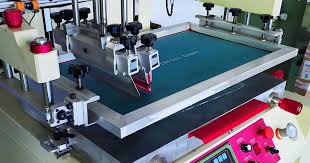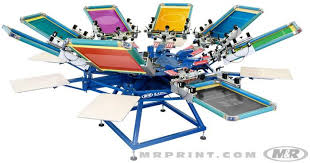Screen printing machine is one of the most popular tools for creating custom designs on clothing, bags, and other materials. If you are starting a small business or just want to make personalized items at home, a screen printing machine can make the work easier, faster, and more professional. These machines come in different sizes and styles, from manual ones for beginners to automatic machines for large-scale production. Knowing which machine fits your needs can save time, money, and frustration.
A good screen printing machine helps you get consistent prints every time, whether you are making T-shirts for a local event or producing items for online sales. It also allows you to experiment with colors, textures, and designs without spending too much on outsourcing. Understanding the features, benefits, and limitations of different machines is key to picking the right one. In this guide, we will explore everything you need to know to make a smart choice and create high-quality prints that stand out.
Table of Contents
What is a Screen Printing Machine and How It Works

A screen printing machine is a device that transfers ink onto a surface using a mesh screen. The design is first made on a stencil, and then ink is pressed through the screen to create the image. This method works on fabrics, paper, plastic, and other materials.
The machine works in a few steps: first, you prepare your screen with a stencil; then, you place your item under the screen; finally, you push the ink through the mesh using a squeegee. The process may sound simple, but the right machine makes it much faster and more accurate. Beginners often start with manual machines, while professionals use automatic machines for bigger orders.
Types of Screen Printing Machines: Manual vs Automatic
There are mainly two types of screen printing machines: manual and automatic.
- Manual Screen Printing Machine: These machines are operated by hand. You use a squeegee to push the ink through the screen. They are affordable, easy to use, and perfect for small businesses or hobbyists. The only downside is that printing large quantities can take time.
- Automatic Screen Printing Machine: These machines do most of the work for you. The screens move automatically, and the ink is applied evenly without much effort. They are more expensive but are ideal for high-volume printing and professional setups.
Choosing the type depends on your budget, the quantity of items you want to print, and your experience level.
Key Features to Look for in a Screen Printing Machine
When buying a screen printing machine, you should check these features:
- Size – Make sure it fits the type of items you want to print.
- Number of Colors – Some machines print only one color at a time, while others can print multiple colors in one go.
- Ease of Use – For beginners, choose a machine that is simple to operate.
- Durability – Look for machines made of strong materials that last longer.
- Adjustable Features – Height, speed, and tension adjustments make your prints better.
Checking these features helps you pick a machine that suits your needs and budget.
Advantages of Using a Screen Printing Machine for Small Businesses
Using a screen printing machine has many benefits:
- Cost-Effective – Printing your designs at home is cheaper than outsourcing.
- Custom Designs – You can create unique designs without limits.
- Professional Quality – Modern machines give smooth, consistent prints.
- Fast Production – Once you learn, you can print many items quickly.
For small business owners, investing in a screen printing machine can be a smart move. It allows you to offer custom products at competitive prices.
Step-by-Step Guide to Using a Screen Printing Machine
- Prepare the Design – Create your design on a stencil or digital file.
- Prepare the Screen – Coat the screen with emulsion and let it dry.
- Expose the Design – Use light to burn the design onto the screen (for photo-emulsion screens).
- Set Up the Machine – Place your item correctly under the screen.
- Apply Ink – Use a squeegee or machine settings to push the ink through the screen.
- Dry the Print – Use heat or air-dry to set the ink.
- Clean the Screen – Wash the screen after printing to reuse it.
Following these steps ensures your prints are clean, clear, and durable.
Common Mistakes to Avoid While Using a Screen Printing Machine
- Using too much or too little ink.
- Not aligning the screen properly.
- Skipping screen cleaning, which can ruin future prints.
- Printing on wet or unprepared items.
- Ignoring safety measures, like gloves or ventilation.
Avoiding these mistakes will save you time and materials and help you make better prints.
Maintenance Tips for Your Screen Printing Machine
- Clean After Every Use – Remove ink and debris to prevent clogging.
- Check Screws and Bolts – Make sure all parts are tight and secure.
- Lubricate Moving Parts – For machines with moving arms or automatic systems.
- Store Screens Properly – Keep them flat and away from sunlight.
Regular maintenance keeps your machine working efficiently for years.
Choosing the Right Screen Printing Machine for Your Budget
Budget plays a big role when choosing a machine. Manual machines are affordable, starting from a few hundred dollars, while automatic machines can cost thousands. Think about how often you will use it, how many items you want to print, and your business goals before investing.
Screen Printing Machine Accessories That Make Life Easier
- Squeegees – Different sizes for different prints.
- Flash Dryers – To quickly dry ink between colors.
- Heat Press – To set the ink permanently.
- Registration Tools – For perfect alignment of multi-color prints.
These accessories improve your workflow and print quality.
Screen Printing Machine vs Other Printing Methods: Which is Better?
Screen printing is known for durability and vibrant colors. Compared to heat transfer or digital printing:
- Pros – Long-lasting prints, works on many materials, cost-effective for bulk orders.
- Cons – Slower for single items, requires setup and cleaning.
For small businesses and custom designs, screen printing machines often provide the best balance of quality and cost.
Conclusion
A screen printing machine is an excellent investment for anyone looking to create custom prints at home or run a small business. By understanding the types, features, and proper use of these machines, you can save time, money, and produce professional-quality designs. With regular maintenance and careful use, your screen printing machine can last for years and help you create unique, high-quality products.
FAQs
Q1: Can beginners use a screen printing machine?
Yes, manual machines are easy for beginners. Start with small projects and gradually learn multi-color prints.
Q2: What materials can I print on?
Screen printing works on T-shirts, hoodies, bags, paper, plastic, and even wood.
Q3: How much does a screen printing machine cost?
Manual machines start from $200–$500, while automatic machines can cost $1,000–$5,000 or more.
Q4: How do I maintain my screen printing machine?
Clean after each use, check screws, lubricate moving parts, and store screens properly.
Q5: Which is better, manual or automatic screen printing machine?
Manual is better for beginners and small batches, automatic is ideal for large-scale production.


